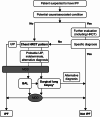Idiopathic Pulmonary Fibrosis for Cardiologists: Differential Diagnosis, Cardiovascular Comorbidities, and Patient Management
- PMID: 30554332
- PMCID: PMC6824347
- DOI: 10.1007/s12325-018-0857-z
Idiopathic Pulmonary Fibrosis for Cardiologists: Differential Diagnosis, Cardiovascular Comorbidities, and Patient Management
Abstract
The presence of rare comorbidities in patients with cardiovascular disease (CVD) presents a diagnostic challenge to cardiologists. In evaluating these patients, cardiologists are faced with a unique opportunity to shorten diagnosis times and direct patients towards correct treatment pathways. Idiopathic pulmonary fibrosis (IPF), a type of interstitial lung disease (ILD), is an example of a rare disease where patients frequently demonstrate comorbid CVD. Both CVD and IPF most commonly affect a similar patient demographic: men over the age of 60 years with a history of smoking. Moreover, IPF and heart failure (HF) share a number of symptoms. As a result, patients with IPF can be misdiagnosed with HF and vice versa. This article aims to increase awareness of IPF among cardiologists, providing an overview for cardiologists on the differential diagnosis of IPF from HF, and describing the signs and symptoms that would warrant referral to a pulmonologist with expertise in ILD. Once patients with IPF have received a diagnosis, cardiologists can have an important role in managing patients who are candidates for a lung transplant or those who develop pulmonary hypertension (PH). Group 3 PH is one of the most common cardiovascular complications diagnosed in patients with IPF, its prevalence varying between reports but most often cited as between 30% and 50%. This review summarizes the current knowledge on Group 3 PH in IPF, discusses data from clinical trials assessing treatments for Group 1 PH in patients with IPF, and highlights that treatment guidelines recommend against these therapies in IPF. Finally, this article provides the cardiologist with an overview on the use of the two approved treatments for IPF, the antifibrotics pirfenidone and nintedanib, in patients with IPF and CVD comorbidities. Conversely, the impact of treatments for CVD comorbidities on patients with IPF is also discussed.Funding: F. Hoffmann-La Roche, Ltd.Plain Language Summary: Plain language summary available for this article.
Keywords: Antifibrotic; Cardiology; Comorbidities; Diagnosis; Idiopathic pulmonary fibrosis; Nintedanib; Pirfenidone; Pulmonary hypertension; Rare disease; Treatment.
Conflict of interest statement
Johan van Cleemput and Andrea Sonaglioni have nothing to disclose. Monica Bengus is a full-time employee of F. Hoffmann La-Roche, Ltd./Genentech, Inc. John L. Stauffer is a full-time employee of F. Hoffmann La-Roche, Ltd./Genentech, Inc. Wim A. Wuyts is on the speakers’ bureau for F. Hoffmann-La Roche, Ltd. and Boehringer Ingelheim. His institution has received funding from both companies. Sergio Harari reports personal fees from Roche, grants and personal fees from Actelion and Boehringer Ingelheim.
Figures


Similar articles
-
Patient characteristics and pharmacologic treatment patterns in antifibrotic-treated patients with fibrosing interstitial lung diseases: real-world results from a claims database.BMC Pulm Med. 2025 May 22;25(1):253. doi: 10.1186/s12890-025-03713-x. BMC Pulm Med. 2025. PMID: 40405141 Free PMC article.
-
The earlier, the better: Impact of early diagnosis on clinical outcome in idiopathic pulmonary fibrosis.Pulm Pharmacol Ther. 2017 Jun;44:7-15. doi: 10.1016/j.pupt.2017.02.005. Epub 2017 Feb 28. Pulm Pharmacol Ther. 2017. PMID: 28257817 Review.
-
The impact of antifibrotic use on long-term clinical outcomes in the pulmonary fibrosis foundation registry.Respir Res. 2024 Jun 21;25(1):255. doi: 10.1186/s12931-024-02883-2. Respir Res. 2024. PMID: 38907239 Free PMC article.
-
Absence of early metabolic response assessed by 18F-FDG PET/CT after initiation of antifibrotic drugs in IPF patients.Respir Res. 2019 Jan 15;20(1):10. doi: 10.1186/s12931-019-0974-5. Respir Res. 2019. PMID: 30646908 Free PMC article.
-
Overview of idiopathic pulmonary fibrosis, evidence-based guidelines, and recent developments in the treatment landscape.Am J Manag Care. 2019 Jul;25(11 Suppl):S195-S203. Am J Manag Care. 2019. PMID: 31419091 Review.
Cited by
-
Prognostic role of CHA2DS2-VASc score for mortality risk assessment in non-advanced idiopathic pulmonary fibrosis: a preliminary observation.Intern Emerg Med. 2023 Apr;18(3):755-767. doi: 10.1007/s11739-023-03219-6. Epub 2023 Mar 25. Intern Emerg Med. 2023. PMID: 36966265 Free PMC article.
-
Association between C-reactive protein and carotid plaque in mild-to-moderate idiopathic pulmonary fibrosis.Intern Emerg Med. 2021 Sep;16(6):1529-1539. doi: 10.1007/s11739-020-02607-6. Epub 2021 Jan 7. Intern Emerg Med. 2021. PMID: 33411265
-
Prognostic Role and Determinants of Ascending Aorta Dilatation in Non-Advanced Idiopathic Pulmonary Fibrosis: A Preliminary Observation from a Tertiary University Center.J Clin Med. 2025 Feb 15;14(4):1300. doi: 10.3390/jcm14041300. J Clin Med. 2025. PMID: 40004830 Free PMC article.
-
Identification of shared molecular mechanisms and diagnostic biomarkers between heart failure and idiopathic pulmonary fibrosis.Heliyon. 2024 Apr 20;10(8):e30086. doi: 10.1016/j.heliyon.2024.e30086. eCollection 2024 Apr 30. Heliyon. 2024. PMID: 38699746 Free PMC article.
-
Exploring the Role of Hemogram-Derived Ratios and Liver Fibrosis Scores in Pulmonary Fibrosis.Medicina (Kaunas). 2024 Oct 16;60(10):1702. doi: 10.3390/medicina60101702. Medicina (Kaunas). 2024. PMID: 39459489 Free PMC article.
References
-
- Raghu G, Remy-Jardin M, Myers JL, et al. Diagnosis of idiopathic pulmonary fibrosis. An Official ATS/ERS/JRS/ALAT Clinical Practice Guideline. Am J Respir Crit Care Med. 2018;198(5):e44–68. - PubMed
-
- Dalleywater W, Powell HA, Hubbard RB, Navaratnam V. Risk factors for cardiovascular disease in people with idiopathic pulmonary fibrosis: a population-based study. Chest. 2015;147(1):150–6. - PubMed
-
- Charoenpong P. Risk of coronary artery disease in patients with idiopathic pulmonary fibrosis: a systemic review and meta-analysis. Am J Respir Crit Care Med. 2017;195:A5430.
-
- Broder M, Change E, Papoyan E, et al. Risk of cardiovascular comorbidities in patients with idiopathic pulmonary fibrosis: analysis of Medicare data. Eur Respir J. 2016;48(Suppl 60):PA4919.
-
- Suzuki A, Kondoh Y. The clinical impact of major comorbidities on idiopathic pulmonary fibrosis. Respir Investig. 2017;55(2):94–103. - PubMed
Publication types
MeSH terms
Substances
Associated data
LinkOut - more resources
Full Text Sources
Other Literature Sources
Research Materials
Miscellaneous

